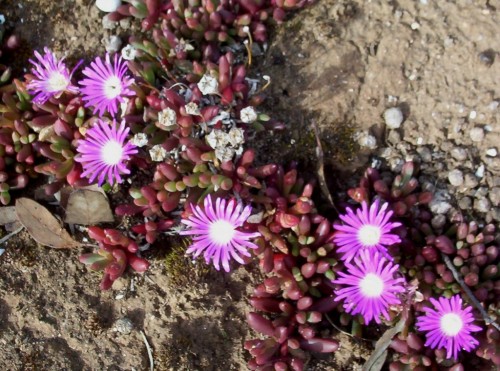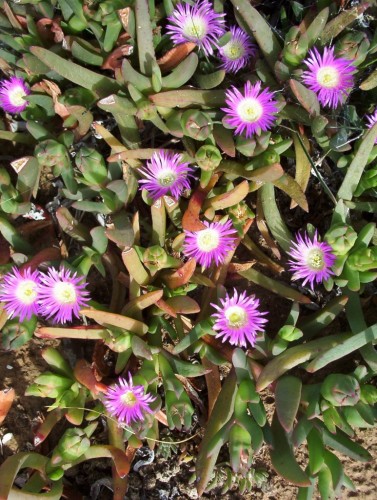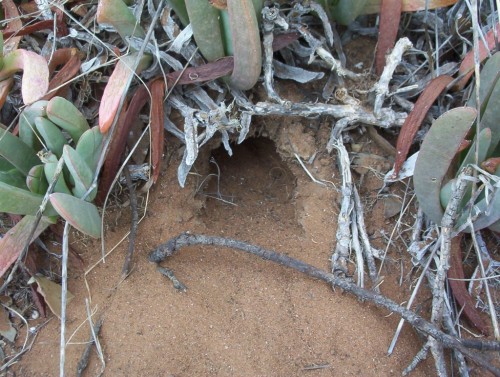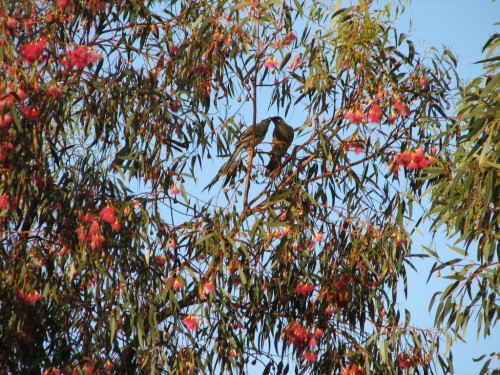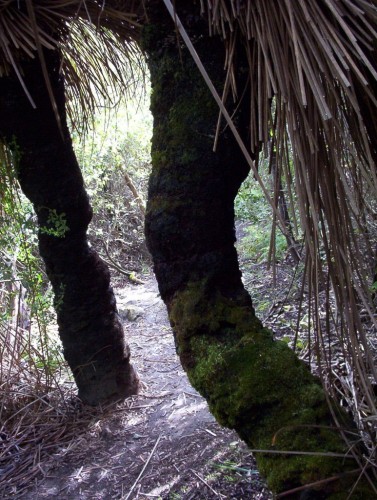The leaves seem to take on the reddish hew when it is in a dry position.
Disphyma crassifolium (Rounded Noon-Flower)
Carpobrotus rossii (Pig Face) In Flower
This is the flower of the succulent plant in the previous post. There were only a few isolated flowers on the plants near the nest. This is a useful plant. Not only is it useful and decorative in the garden, it is one of the bush tucker plants used by the local Aboriginal group. The leaves and fruits were used as a kind of relish to be eaten with meat. The juice from the leaves is also said to be an insect repellant. As with any new thing, a cautious test should be done before slathering one’s skin with the juice of an unknown plant.
I guess the same could be said for the plants in the Aloe family. Aloe Vera is good on a number of skin ailments but I am never sure which member of the species is the one to use.
Carpobrotus rossii (Pig Face, Karkalla)
Husband was checking out a pigeon’s nest in the corner of our block when a small bird seemed to fly from under his foot. Closer inspection revealed this little burrow at the base of the pig face, Carpobrotus rossii. The bird is the Spotted Pardalote. These and Rainbow Bee Eaters make burrows in sandy banks or cliff faces. During the spring and summer we often find scratchings that indicate the beginnings of burrows and it is quite exciting to actually have one being constructed on our place. Husband was able to get a photo of the bird carrying grass to the burrow to line it.
The nest is in the middle of the patch of this Pig Face. It is a very hardy plant like all succulents seem to be. I will be planting some of this on the edge of our driveway to create the illusion of ‘lawn’. There is no way that I could keep lawn going there and I wouldn’t want to anyway because it would be a waste of water.
Eucalyptus leucoxylon (South Australian Blue Gum)
This is one of those situations where one cannot use the common name for the species. Blue gum is the common name given to a few Eucalypts. The Tasmanian Blue Gum is Eucalyptus globulus. The Victorian Blue Gum is Eucalyptus globulus subspecies bicostata. The Sydney Blue Gum is Eucalyptus saligna.
This photo has Little Wattle Birds in the canopy of the tree. We were visiting a garden and sitting outside having a cuppa watching all this bird activity.
Xanthorrhoea semiplana (Yacka, Grass Tree)
This photo was taken because it was fascinating to see the age of these Grass Trees. The walking path passed between these two trunks. There is moss growing on the trunks. I would love to at least see my little plant make the canopy of leaves showing on these.
This plant seems to be a very hardy one once established. The flower stalk can be up to two and a half metres long. They often have a kink or distortion in the spike.
